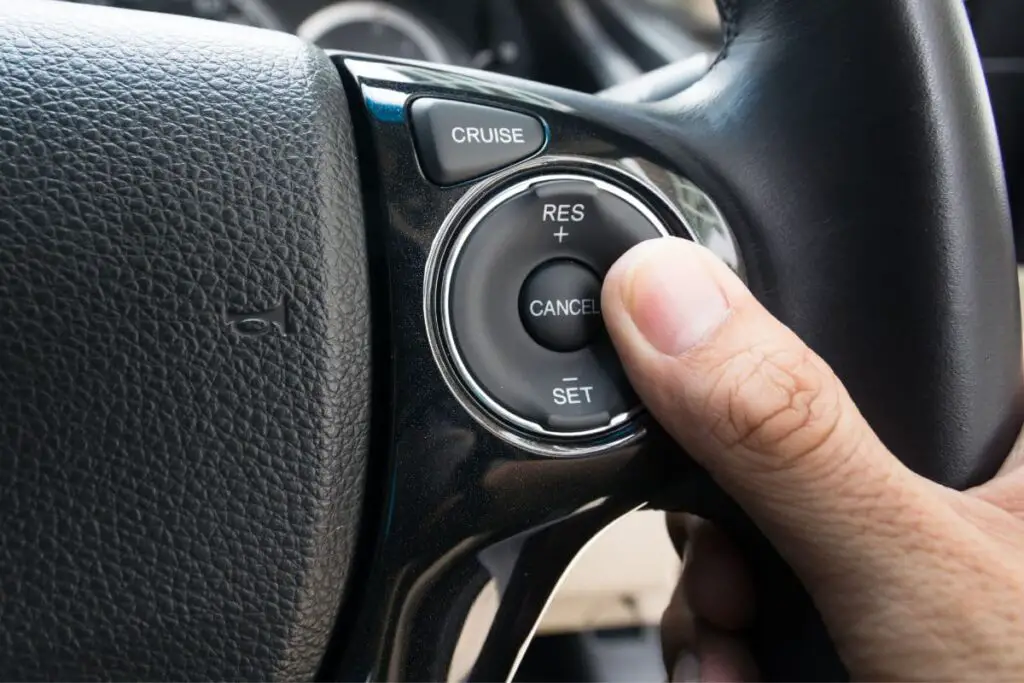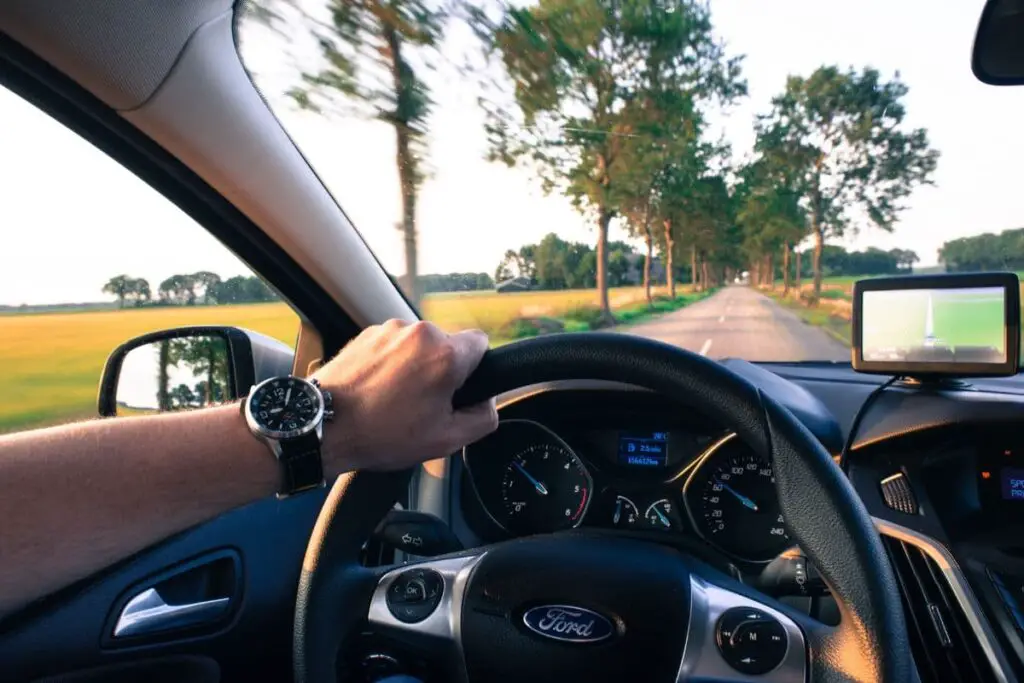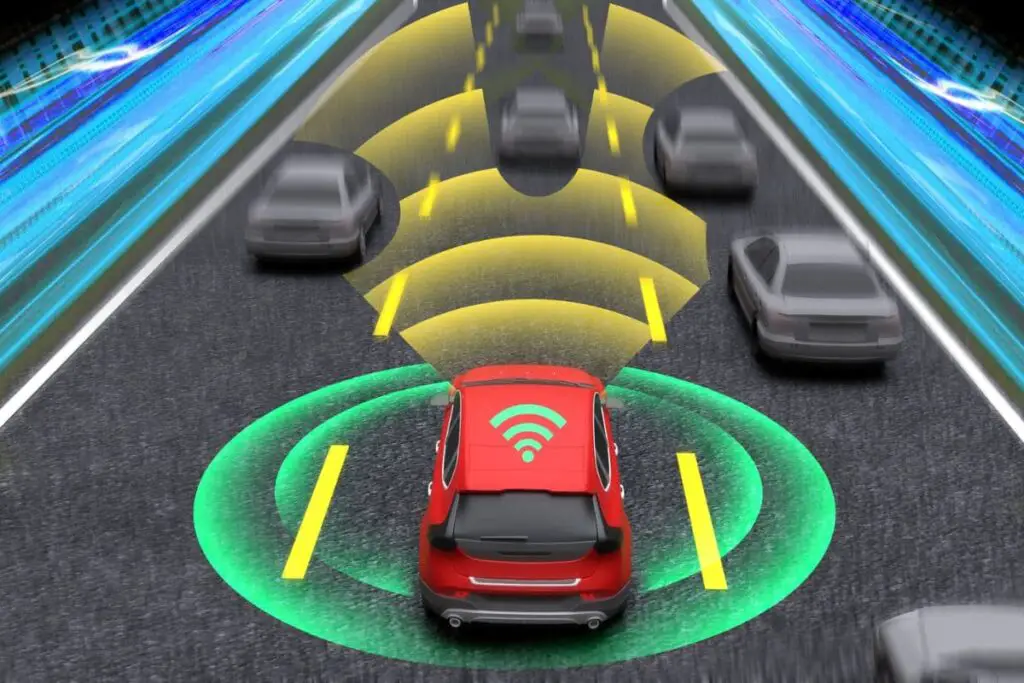As an Amazon Associate, we earn from qualifying purchases. We may also earn commissions if you purchase products from other retailers after clicking on a link from our site.
Cruise control is a great feature, especially if you frequently drive long distances. It can help prevent overspeeding, including inadvertent accelerations by fatigued drivers. But what should you do in bad weather, and can you use cruise control in the rain?
You shouldn’t cruise control in the rain. Your cruise control speed can be unsafe when it is raining, and using cruise control can also slow down your reaction time. It’s better to stick to manual speed control to help you better assess road conditions in the rain and detect potential hazards.
Contrary to what some people believe, cruise control won’t cause overspeeding in the rain, and the car will maintain the speed you select. However, there are a few safety issues that you must consider seriously. I’ll discuss those below.

Why You Shouldn’t Use Cruise Control When It’s Raining
The cruise control feature isn’t identical for all cars, including different models of the same brand. You may have either conventional or adaptive cruise control in your car. Some companies, like General Motors, have additional capabilities for this feature, such as Super Cruise.
I will cover all these versions while explainingthe pertinent safety concerns of using cruise control in the rain.
Your Cruise Control Speed May Be Unsafe When It’s Raining
The cruise control feature in your car often has a minimum speed limit of 25 mph (~40 km/h).
This slow speed is unlikely to be a risk factor as an isolated element. However, many people have their cruise control speed set much higher than the minimum.
For cautious and safe driving, you should reduce the speed when it’s raining.
How much you slow down (or the reduced speed you set for cruise control) depends on your driving skills and the severity of the rain. The general recommendation is reducing normal speeds by a third in wet conditions.
Hence, if you are cruising at 60 mph (96.5 km/h), the speed on the same route when it’s raining should be 40 mph (64.4 km/h).
However, people often reduce the speed further during a torrential downpour or if visibility is a problem. Likewise, the road conditions will influence the speed at which they set their cruise control.
Therefore, you shouldn’t use cruise control set at your normal speeds on any route in the rain. You should revise it and reduce the speed—and that is only if you choose to use cruise control.
Cruise Control Can Increase the Reaction Times of Drivers
Cruise control can increase your reaction time and significantly affect your control of the vehicle. This applies to both conventional and adaptive cruise control.
A study assessed the active emergency braking response of a few male drivers aged between 22 and 67 years. The researchers covered the following:
- Manual driving
- Conventional cruise control
- Adaptive cruise control
Here are the findings published by the National Institutes of Health:
- The overall impact on control was delayed by 36 ms with adaptive cruise control.
- Cruise control delayed the brake reaction time of drivers by 13 ms.
- The delay in peak braking force was significantly longer at 70 ms.
70 ms or 0.07 seconds may not sound a lot or too long in normal conditions, but it can be critical in the rain, especially when there’s a hazard ahead. Additionally, cruise control can make drivers less alert and less cautious—and that’s precisely what another study focused on.
According to another study published by the Association for Psychological Science, a driver can take up to 5 seconds longer to maneuver, react to an obstacle ahead, or slow down when using conventional or adaptive cruise control.
5 seconds is a long time, especially in the rain.
Road grip and visibility are already major concerns when it’s raining. A delayed reaction time can be the difference between an accident and getting home safe.
Adaptive Cruise Control Doesn’t React As Fast as Humans
The conventional cruise control merely maintains a selected speed, while adaptive cruise control also keeps a safe distance from a car or vehicle in front.
You can increase this gap time with adaptive cruise control when it rains. However, the response time of adaptive cruise control remains a concern.

According to the Institute of Electrical and Electronics Engineers, most adaptive cruise control systems have a response time of 1.1 seconds, significantly longer than human drivers. This delayed response time may cause an accident if an obstacle or a vehicle ahead poses a threat.
Cruise Control Doesn’t Detect Hazards and Road Conditions
Neither conventional nor adaptive cruise control can detect hazards or road conditions, regardless of whether the weather is inclement or pleasant. Rain will likely affect your visibility, and cruise control might adversely affect your alertness, control, and reaction times.
Your foot won’t be on the accelerator during cruise control, so your braking might take longer if there’s any danger ahead.
Plus, the wet road or terrain is unlikely to offer the firm grip your car or its tires have in normal conditions. And there’s the possibility of hydroplaning.
Cruise control doesn’t cause aquaplaning or hydroplaning per se. The speed you select and the wet road cause the problem, which is more likely and may worsen if your tires have worn down treads. Furthermore, cruise control won’t make any changes by itself if your car hydroplanes.
So, you will continue to cruise at a selected speed even if your car aquaplanes. The maximum a conventional cruise control feature may do is decelerate your car if it senses a faster speed than what you have selected. This may happen if the tires lose contact with the road or track.
A car at a very high speed can lose contact with the road when there’s standing water, especially if the tires have treads worn down to 3 mm (0.12 inches). Tire treads with a depth of 1.6 mm (0.06 inches) are highly vulnerable to hydroplaning.
Since hydroplaning lifts the tires, there’s less friction due to the loss of contact with the road, and the wheels spin faster. Your car’s cruise control may detect this as crossing your selected speed limit, so it may decelerate a little. This deceleration doesn’t avert hydroplaning and other risks.
In fact, the increased level of road hazards is also one of the main reasons drivers test get canceled during heavy downpours.
Conventional Cruise Control Doesn’t Assess the Traffic Ahead
Conventional cruise control doesn’t use cameras or radars to sense the presence of another car or vehicle ahead of yours. Such systems don’t decelerate if the vehicle in front slows due to any reason or when there’s an accident ahead in your lane.

A car or vehicle ahead of you is also at risk of hydroplaning in the rain, among other hazards. A conventional cruise control system won’t assess any obstacles or traffic ahead, creating a potential collision if the car in front brakes, stops, or even reduces its speed for any reason.
Conclusion
It’s true that you’ll probably be more alert while using cruise control in the rain than you are when driving in pleasant conditions.
However, you still shouldn’t use cruise control for the reasons I’ve shared in this post. The poor visibility, skidding, and traffic-related hazards that often accompany driving in the rain make using cruise control a dangerous idea.
